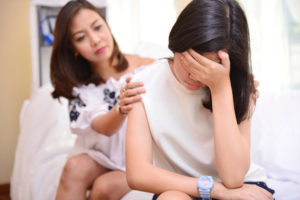Too many stories point to the troubled minds and mental struggles of our youth with the tragic event in Parkland, Florida being one of the latest. Even more saddening, these children’s cries for help are often misunderstood or ignored.
Suicide is the second leading cause of death for children between the ages of 10–24 years old, accounting for 17.6% of deaths in this age group 1 The American Academy of Pediatrics recently updated their guidelines to include universal screening for adolescent depression (youth 12 years of age and older). According to the 2016 National Survey on Drug Use and Health, one in eight youth ages 12–17 years old has had a major depressive episode in the past year, with 70% of them having severe impairment.
For young Asian Americans and Pacific Islanders (AAPIs), the suicide rates are also bleak. AAPI adolescent females (15-19 years old) have a higher rate of suicide deaths (21.9%) compared to non-Hispanic Whites, non-Hispanic Blacks, and Hispanics. AAPI males aged 15–19 years have comparable or higher rates of suicide deaths (27.1%) when compared to all other racial and ethnic groups.

The Model Minority Myth is a stereotype that portrays all Asian Americans as academically gifted and successful. This myth wrongly portrays AAPIs as a prosperous group who have secured economic and educational success, have fewer health problems than the overall population, and do not need public assistance. In reality, AAPIs are a very heterogenous group with immigration from more than 30 different countries and ethnic groups, hundreds of languages and unique dialects, and varying degrees of economic and academic success.
In the U.S., only half of adolescents with depression are diagnosed, and among them, approximately 60% do not receive appropriate treatment. This situation is amplified in the AAPI community due to stigma and cultural barriers.
Many AAPIs face multiple challenges, including lack of health insurance, limited English proficiency, difficulty of acculturation and lower socioeconomic status. Less than half of AAPIs would seek help for their emotional or mental health concerns than their white counterparts. AAPIs tend to dismiss, psychosomaticize, deny or neglect their depressive symptoms for different reasons, such as different conceptualizations of mental health and illness or avoiding family shame.
These reasons have prevented many AAPIs from seeking mental health counseling or medication. Parental expectations in academic excellence, cultural/family obligations, identity conflicts, societal unconscious bias, and discrimination are some of the daily challenges confronting AAPI youth and young adults.
Parental warmth, family cohesion, and strong intergenerational relationships can help AAPI adolescents in expressing experiences with bullying and minimizing internalizing issues with immigrant parents, teachers, or the education system. It is critical for the AAPI community to continually strengthen family/parenting skills, build resiliency, and reduce risks for adolescent anxiety and depression. Safe, supportive, and nurturing relationships are important to children. Strong and positive self-esteem is extremely vital and can be associated with reduced risk of depression.
There is an urgent need to improve the mental well-being of future AAPI generations. Learning how to cope with various stressors that life throws at them, work productively and fruitfully, and contribute to their community and society are key for the younger AAPI generations to actualize the great potential that lies within them. It is equally important to reduce the stigma about mental health among the AAPI community and encourage seeking help and counseling when needed. We have a lot of work to do.
Parents, teachers and friends need to know the signs of anxiety and depression, and “act early.” The Centers for Disease Control and Prevention (CDC) offers several suggestions on their Children’s Mental Health website:
Anxiety
- Being very afraid when away from parents (separation anxiety)
- Having extreme fear about a specific thing or situation, such as dogs, insects, or going to the doctor (phobias)
- Being very afraid of school and other places where there are people (social anxiety)
- Being very worried about the future and about bad things happening (general anxiety)
- Having repeated episodes of sudden, unexpected, intense fear that come with symptoms like heart pounding, having trouble breathing, or feeling dizzy, shaky, or sweaty (panic disorder)
Depression
- Feeling sad, hopeless, or irritable a lot of the time
- Not wanting to do or enjoy doing fun things
- Changes in eating patterns – eating a lot more or a lot less than usual
- Changes in sleep patterns – sleeping a lot more or a lot less than normal
- Changes in energy – being tired and sluggish or tense and restless a lot of the time
- Having a hard time paying attention
- Feeling worthless, useless, or guilty
- Self-injury and self-destructive behavior
Read more on NIMHD.HIV.gov.

Leave a Reply
You must be logged in to post a comment.